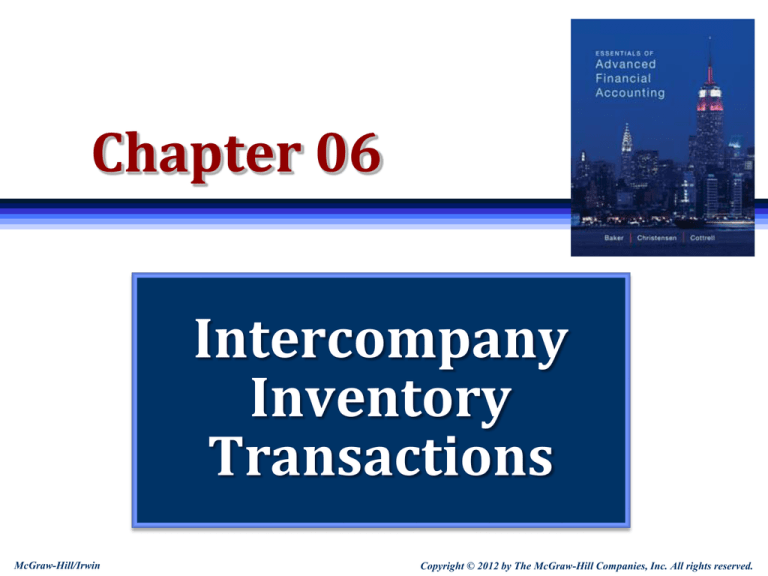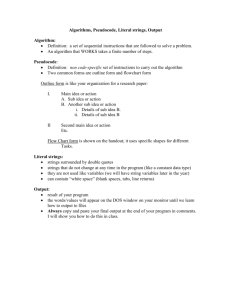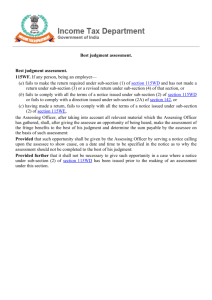
Chapter 06
Intercompany
Inventory
Transactions
McGraw-Hill/Irwin
Copyright © 2012 by The McGraw-Hill Companies, Inc. All rights reserved.
Learning Objective 1
Understand and explain
intercompany transfers and
why they must be
eliminated.
6-2
Road Map: Intercompany Transactions
Typical intercompany transactions
Intercompany reciprocal accounts (Chapter 4)
Inventory transfers (Chapter 6)
Fixed asset transfers (Chapter 7)
Intercompany Indebtedness (Chapter 8)
6-3
Arm’s-Length Transactions
Q:
What are “Arm’s-length” Transactions?
A:
“Transactions that take place between
completely independent parties.”
6-4
Categories of Transactions
Arm’s Length Transactions
The only transactions that can be reported in the
consolidated statements.
We want to report the results of our interactions
with outside parties!
Non-Arm’s Length Transactions
Usually referred to as “related party
transactions.”
Include all intercompany transactions.
6-5
Types of “Related Party” Transactions
Involving only Individuals
Transactions among family members
Involving Corporations
With management and other employees
With directors and stockholders
With affiliates (controlled entities)
Probably constitutes at least 99% of all corporate
related-party transactions
6-6
Necessity of Eliminating Intercompany Transactions
Eliminate all intercompany transactions in
consolidation:
Because they are internal transactions from a
consolidated perspective.
Not because they are related-party transactions.
Only transactions with outside unrelated parties
can be reported in the consolidated statements.
6-7
Let’s work through an example:
Assume Parent Co. owns 100% of Sub Co.
The following intercompany transactions occurred during
the year:
Parent loaned $500 to Sub. To keep things simple, assume that
there is no interest revenue or interest expense associated with this
loan.
Parent made a sale to Sub for $400 cash. The inventory had
originally cost Parent $250. Sub then sold that same inventory to an
outsider for $500.
Parent made a sale to Sub for $300 cash. The inventory had
originally cost Parent $200. Sub has not yet sold that same
inventory to an outsider.
What consolidation worksheet entries would you make?
6-8
(a) Loan from Parent to Sub
Does this transaction include outsiders?
Parent $500
Sub
Reverse the entries made by
the parent and the sub.
To eliminate intercompany loans:
Loan Payable
Loan Receivable
Parent:
Receivable
Cash
Sub:
Cash
500
500
500
Payable
500
500
500
6-9
(b) Sale from Parent to Sub to Outsider
Arm’s
Length
Keep Parent’s COGS
Keep Sub’s Sale
Are these legitimate transactions?
$250
Keep
This
Purchase
Parent $400
Eliminate effect
of this internal
Transaction
Get rid of Parent’s Sale
Sub
$500
Keep
This
Sale
Get rid of Sub’s COGS
Internal (fake)
6-10
(b) Sale from Parent to Sub to Outsider
Which transactions are legitimate?
Parent’s sale to Sub:
Sub’s sale to Outsider:
Parent:
Cash
Sales
COGS
Inventory
Sub:
Inventory
Cash
Sub:
Cash
500
Sales
500
COGS
400
Inventory
400
400
400
250
250
400
400
Reverse the rest!
To eliminate sale from Parent to Sub to Outsider:
Sales (parent to sub)
400
Cost of Goods Sold (to outsider)
400
6-11
(c) Sale From Parent to Sub (Not Outside)
Is this a legitimate arm’s length transaction?
$200
Keep
this
purchase
Parent $300
Sub
Eliminate effect
of this internal
transaction
Parent:
Cash
300
Sales
300
COGS
200
Inventory
200
Sub:
Inventory 300
Cash
300
Summary of the Transaction:
Parent purchased inventory for $200.
Parent sold the inventory to a Sub for $300.
Reverse the entries made by the parent and sub.
6-12
(c) Sale From Parent to Sub (Not Outside)
Reverse the entries made by the parent and sub.
Parent:
Cash
300
Sales
300
COGS
200
Inventory
200
Sub:
Inventory
Cash
Parent $300
Sub
300
300
To eliminate sale from Parent to Sub, not yet to Outsider:
Sales
300
Cost of Goods Sold
200
Inventory (net)
100
6-13
Summary of Consolidation Entries:
To eliminate intercompany loans:
Loan Payable
Loan Receivable
500
To eliminate sale from Parent to Sub to Outsider:
Sales
400
Cost of Goods Sold
500
400
To eliminate sale from Parent to Sub, not yet to Outsider:
Sales
300
Cost of Goods Sold
200
Inventory
100
6-14





